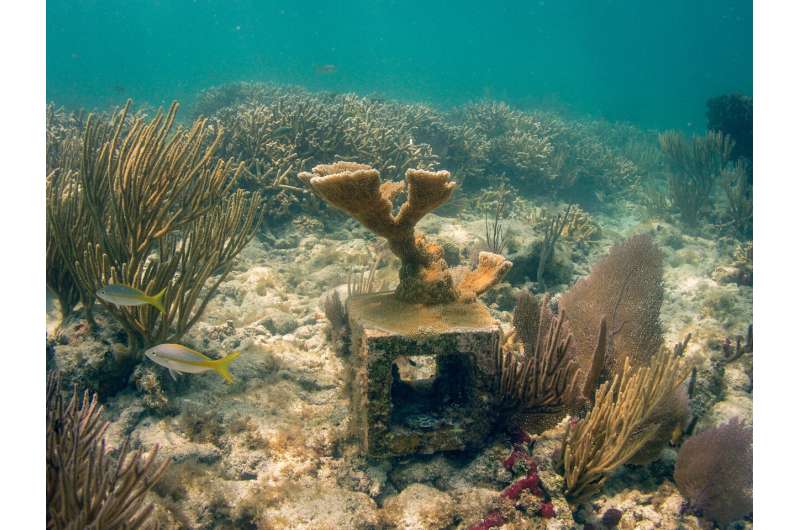This article has been reviewed according to Science X's editorial process and policies. Editors have highlighted the following attributes while ensuring the content's credibility:
fact-checked
peer-reviewed publication
trusted source
proofread
In Florida, endangered coral finds a way to blossom

In a new study, researchers have found that the restoration efforts of the critically endangered species elkhorn coral depend largely on the animal's location, microbiome, and the right conditions to provide an abundance of food.
Their findings showed that the unique oceanographic conditions in Florida's Dry Tortugas National Park provided corals with an opportunity to flourish, enhancing both coral growth and survivorship while positively influencing the coral's microbiome—the thousands of diverse microbes that are naturally associated with them. The research also indicates that restoration efforts for the species would be most successful in areas that exhibit higher food availability, or places abundant with zooplankton, a key source of nutrition that aids in coral tissue building and repair.
Over the last few decades, marine disease, climate change and a number of other environmental stressors have caused the elkhorn coral (Acropora palmata) population—once a major engineer of the reef ecosystem in the Caribbean—to experience a dramatic decline. Although small patches of these corals are still found in the Caribbean, today the species appears to be functionally extinct in Florida, said Andréa Grottoli, senior author of the study and a professor of Earth sciences at The Ohio State University. While there are coral colonies left, there aren't enough of them to effectively reproduce.
"In other parts of the Caribbean, there are little pockets where there are enough of them, but in general, elkhorn coral is a highly sensitive species," said Grottoli. "It's no longer the primary coral on the Florida and Caribbean reefs, and that's a huge loss to that reef ecosystem function."
In the Florida Keys, healthy coral reefs help minimize coastal erosion and contribute greatly to the region's economic stability through federally managed fisheries and other tourism-based ventures, providing motivation for government agencies and scientists alike to find the best strategies for restoring the vital species.
The study, published today in the journal Communications Earth & Environment, describes how researchers aimed to do this by studying environmental variables that might contribute to the species' survival. In 2018, researchers at the United States Geological Survey (USGS) placed replicated elkhorn colonies in five different locations along Florida's offshore coral reef. After two years, Grottoli's team sampled the coral's physiology to compare how the colonies fared.
Grottoli's team measured a number of physiological traits important to the coral's survival, including biomass, fat content and various markers for coral feeding.
Overall, the health profiles of the elkhorn coral greatly differed among the five areas, but only the coral samples in the Dry Tortugas thrived compared to all the other sites, said Grottoli, as certain biological traits indicated that the Dry Tortugas corals were eating more zooplankton.
The favorable conditions these corals experienced are likely due to the site's propensity for periodic upwellings, a wind-driven oceanographic phenomenon that can bring bursts of nutrient-rich water up to the surface from colder, deeper waters. These events stimulate zooplankton production and bring large quantities of the food source into the region, making the area a veritable oasis for elkhorn coral.
"These little pulses of extra food can make a big difference in coral survival and the things we measured are consistent with that interpretation," said Grottoli.
Grottoli said their research was challenged by early COVID-19 travel constraints and bad weather, but the results add to a growing body of evidence that the Dry Tortugas would be a logical place to attempt to restore elkhorn coral. The study notes that restoring elkhorn corals in the Dry Tortugas may also provide a source population for new coral recruits throughout the Florida Keys, but further research is needed to determine if other at-risk species of coral may also thrive there, Grottoli said. Still, it won't solve all the issues facing endangered coral populations.
"We're trying to make smart conservation and restoration decisions, but at the core of this work is that coral reefs are declining because of climate change and local stressors like overfishing and pollution," said Grottoli. "Until we address those two things, no matter how smart we are about coral restoration and conservation, we're always just putting a band-aid on it."
More information: Leila Chapron et al, Heterotrophy, microbiome, and location effects on restoration efficacy of the threatened coral Acropora palmata, Communications Earth & Environment (2023). DOI: 10.1038/s43247-023-00888-1
Journal information: Communications Earth & Environment
Provided by The Ohio State University


















